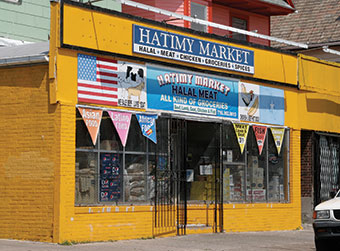From Refuge to Renewal
by Ann Marie Awad

How refugees from Somalia and elsewhere promise to transform and revive Buffalo's West Side
Relocating from a place where the breeze off the Indian Ocean is warm and welcome to a place as cold as Buffalo in winter is no easy task. But for Somalis coming from a country ravaged by war, a second chance and good neighbors are well worth the chill. The United States alone, through the Federal Refugee Resettlement Program, has admitted nearlyly 84,000 Somali refugees since 1983, and more than 43,000 since the events of September 11, 2001, which temporarily halted refugee resettlement. According to the Migration Policy Institute, the US has accepted more refugees from several areas for resettlement than any other country with traditional resettlement programs.
For Ali Mohamed, who arrived in America at the age of seven, the transition was not easy. “I had to deal with racism. I think everybody in America deals with that. It just made me a stronger person,” he says.
Mohamed, 25, opened Hatimy Market in 2005, a halal foods market which also carries Mexican and Asian products. He comes from Merca, a port city on the southern coast of Somalia that faces the Indian Ocean. One of nine children, he came to the US in 1993 and lived in Boston for 10 years before coming to Buffalo. He graduated from the University at Buffalo with a B.A. in biomedical sciences but he decided to open up a market in the area because he noticed that Somalis had nowhere to buy halal meats and the spices they’re accustomed to use in cooking.
He speaks with almost no discernible accent, saying that English was very easy for him to pick up because he was a child when he came to America. When customers come into the store, he slips right into his native tongue, greeting them heartily in Somali.He explains that while there are several dialects that Somalis speak, almost everyone can understand the main Somali tongue.


The Office of Federal Refugee Resettlement, which belongs to the Department of Health and Human Services Administration for Children and Families, offers limited assistance to those granted asylum. Usually, nonprofit organizations such as Catholic Charities will sponsor a family to seek asylum from the federal government. They will be placed, and then a resettlement case worker will work with them to help them integrate into the community, apply for citizenship, and sign up for English classes. Nonprofits generally provide refugees with the resources they need to become permanent residents.
Buffalo has one dedicated refugee resettlement program, as well as other institutions that aide in resettlement, such as the International Institute of Buffalo. Journey’s End Refugee Services was founded in 1987 by Reverend James Hill and boasts a staff of 15. Since its inception, Journey’s End has resettled more than 2,000 refugees in the city of Buffalo—from Cambodia, Ethiopia, Poland, Romania, the former Soviet Union, Sudan, Iraq, Cuba, Bosnia, Somalia, Burma, and Rwanda. Since 1999, Journey’s End has found work for 300 refugees through its job placement program.
Journey’s End provides refugees with intensive aid for their first four months here, helping to get them into houses, jobs, and English classes, as well as getting their immunizations up to date and providing special assistance for pregnant women. In those first four months, Journey’s End aims to get refugees fundamentally established in the community, but services are still available to refugees well after that period.
“We try to help them find jobs within the first four months,” says Molly Short, executive director of Journey’s End. “Right now the economy is a little bit slower so we’re getting full employment four to eight months after arrival on average.
“Some of the cases that come in are in need of much more support. For example, we had a family come in that were Somali out of one of the really bad camps in Kenya, and there’s a lot of malnourishment and a lot of other issues that have to be dealt with before they can even consider working. Then other times, people come in and they’re in good condition before they come over; they’re in camps where there’s more food available, or they have some training from the United Nations, and that gives us more to work with when it’s time to help them find employment.”
Short sees many cases of culture shock among Somali refugees, but the most startling issue is malnourishment. “You know how after the Depression, [with] people of that generation, you would go into their basement and find a year’s worth of toilet paper? Kind of that same phenomenon happens for refugees coming from severe situations,” she says. “That’s something you just can’t leave behind, that fear of not having enough.”
Journey’s End partners with several other local organizations to get the job done. Aside from standard contracts with social services, social security and other such core providers, Hope Refugee services, a component of Jericho Road ministries, assists by dealing primarily with housing and educational needs. Dr. Myron Glick of the Jericho Road Family Practice helps by examining refugees and addressing medical concerns. “There’s no way we can do this by ourselves. We have to incorporate community partnerships,” Short says.
Although Somalis are not the primary group that Journey’s End deals with, several hundreds of them have come through their program. “The Somalis are very loving and wonderful people and they work hard to take care of themselves and to become contributing members of the community,” says Short. “They just have different challenges than other refugee groups may because of the conditions in Somalia.”
“We help the community and the community helps us,” says Mohamed. The serrated hiss of a band saw drones from the back of the store where an employee breaks down hunks of meat, bone and all. The place is small, but packed with products: cardamom teas, basmati rice, fish, goat, and mango nectar. “We sell only halal meat, we don’t sell any beer, wine or liquor or porn,” Mohamed says. “That’s one of the main advantages we have, that we’re a halal foods store. We sell about a ton of goat a month.”
Neighborhood markets like Hatimy have been popping up all along Grant Street. There are three Somali-owned markets and one Somali and Puerto Rican restaurant. Bob Frank, executive director of the Grant-Ferry Association, wants to ensure that these businesses stay open and make way for more. “[They] strike me as if they’re prepared to create a real community. For me, that means a great possibility for the street in reflecting that need,” says Frank. “Our long-term vision for Grant-Ferry district is one that’s very multi-ethnic [and] multi-cultural.”
Grant Street, once an Italian haven, is dotted on each side with run-down businesses, mostly old Italian markets and restaurants. Drive down Grant and you’ll see the colors of the Italian flag—often in chipped, fading paint—at least once a block. “Old identities have fallen. It’s no longer an Italian community,” Frank says.
The Grant-Ferry Association works towards strengthening the commercial district. Frank believes that the Somalis will play an important role in thre Grant Street’s revival. “If in five years we see three or four markets on the street and additional retail, different kinds of clothing stores, restaurants and whatnot that are clearly identified with Somali culture, we’ll see that as a group that’s succeeding and a group that’s ready to contribute in a big way.”
One such business is the Somali Star, which originally occupied a small yellow building. That restaurant closed for lack of business, Amina Hernandez, decided to start over again, serving both Somali and Puerto Rican food. “We just decided to cook Somali and Spanish food. My husband is Puerto Rican, so we’d rather just keep both foods going,” says Hernandez, who is 23 years old.
Now an eat-in restaurant, serving piping hot plates of curried goat or chicken, rice and pastelillos, a flurry of languages is heard every time the door jingles to welcome more customers. They order in Somali or Spanish, and Hernandez, always smiling, prepares them plates of mix-and-match delicacies. “I think Grant Street is perfect,” she says. “All the different diverse groups living all in the same spot. I never want to move out of here.”
Hernandez is one of five girls. She came straight to Buffalo from Mogadishu, Somalia’s capital city. “My father wanted us to come here and go to school and get out of the war. To get an education.”
Having arrived when she was 11, she faced the challenge of learning English. “At first I couldn’t speak English and that was hard, but I started learning,” she says. “[It] took me about two years. I used to watch cartoons in the morning. They helped out a lot.” She expresses some concern about her children’s’ ability to pick up English. At three and two, she says, “they know a couple of words in Somali and a couple of words in Spanish but they don’t know English.”
Hernandez has fond memories of her adolescence in Buffalo. She attended Grover Cleveland High School, and she describes the overwhelming cultural diversity that eased her transition from refugee to citizen. “You walk down the hallways and you hear all sorts of languages being spoken,” she says. Her peers were just like her, from all over the place, settled here together and learning to make a new life. “That made it easier,” she says.
Like many of Buffalo’s Somalis, Hernandez calls Grant Street her home. “I know every block. I can walk around. I feel comfortable. Safe and comfortable.”
Mohamed, who is a good friend of Hernandez, seems to agree. “I love it. It’s a great neighborhood. It’s more accepting and more welcoming because it is heavily populated by immigrants,” he says.
But it’s clear that there is still work to be done within the community. “It’s not generational yet. I think you need two or three generations before you can establish a presence anywhere,” says Frank. Many Somalis in the area still don’t know enough English to get by. Although people like Mohamed and Hernandez came to America at a young age and adapted as they grew, their parents’ generation still struggles with life in America. “We need to have more offices that can help them,” says Mohamed. “People come here to have us read their letters.”
From the look of it, the Somalis aren’t going anywhere. Instead of running a restaurant devoted solely to Somali needs and desires, Hernandez makes Puerto Rican food, too, and Hatimy Market sells adobo right next to the cardamom teas. Other parts of the Grant community seem to have responded to the newcomers, as well: Guercio and Son’s Italian market also carries Middle Eastern goods now, and Lorigo’s market down the street carries Hispanic foods. To Mohamed, it makes sense. “I realize that the West Side is full of everybody, so that’s the way our operation is run,” he says. “We just cater to everybody.”
For people escaping famine, piracy, civil war, and clan violence, the journey is not easy. In the waiting room at Journey’s End, there is a Somali prayer framed on the wall:
“And in random scorching flame of wind that parches the painful throat and sears the flesh, may God, in compassion, let you find the great-boughed tree that will protect and shade.”
blog comments powered by Disqus|
Issue Navigation> Issue Index > v9n27 (week of Thursday, July 8) > From Refuge to Renewal This Week's Issue • Artvoice Daily • Artvoice TV • Events Calendar • Classifieds |









 Current Issue
Current Issue